The Epps Family and Homeopathy
July 30, 2008
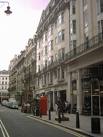 The Epps family was in every sense a
phenomenal homeopathic family, comprising several homeopathic physicians
and pharmacists.
Their main pharmacy was established in 1839 at Jermyn Street, SW1 1839,
with other shops opening in 30 Upper King Street, Bloomsbury in 1840,
and 112 Great Russell Street, Bloomsbury in 1842 (D Betty Griffin,
Biggin Wood
Norbury,
(Local History Publications, Streatham 2005) Chapter 5).
The Epps family was in every sense a
phenomenal homeopathic family, comprising several homeopathic physicians
and pharmacists.
Their main pharmacy was established in 1839 at Jermyn Street, SW1 1839,
with other shops opening in 30 Upper King Street, Bloomsbury in 1840,
and 112 Great Russell Street, Bloomsbury in 1842 (D Betty Griffin,
Biggin Wood
Norbury,
(Local History Publications, Streatham 2005) Chapter 5).
Dante Gabriel Rossetti and his brother William Michael Rossetti were close friends of the Epps family (William Michael Rossetti, Roger W. Peattie (Ed.), Selected Letters of William Michael Rossetti, (Penn State Press, 1 Nov 2010). Multiple pages). The Epps family also knew Jacob Bright, John Bright, Giuseppe Garibaldi, Giuseppe Mazzini, Felice Orsini, Peter Stuart, James John Garth Wilkinson, and very many other movers and shakers of the 19th Century.
From D Betty Griffin, Biggin Wood Norbury, (Local History Publications, Streatham 2005) Chapter 5. The Epps family came from Ashford, Kent. John Epps senior married twice and had three sons, John, the eldest was born in 1805, and then George Napoleon was born in 1815, and then their half brother James was born in 1821. John Epps senior was a provision merchant who lived in London, and his father was the licensee of the Bull Inn in Rochester (see Charles DickensPickwick Papers). The family fortunes in the 18th century are ’… too obscure to follow…’ though when Charles II was in exile, an Epps served him as an equerry and returned with the king at the Restoration, and the family eventually settled in Kent.
The Epps family was an English family, well known in commerce and medicine. In the second half of the 18th century they had been settled near Ashford, Kent, for some generations, claiming descent from an equerry of Charles II, but were reduced in circumstances, when John Epps rose to prosperity as a provision merchant in London, and restored the family fortunes.
He had four sons, of whom John Epps, George Napoleon Epps, and James Epps were notable men of their day, the two former were prominent doctors who were ardent converts to homoeopathy, and James was a homoeopathic chemist and the founder of the great cocoa business associated with his name.
Among George Napoleon Epps’s children were Washington Epps, a well known homeopath, Laura Theresa, Lady Alma Tadema, and Mrs. Edmund William Gosse.
 Ellen Elliott Epps 1808-1876
wife of John
Epps
Writer on health
issues.
Ellen Elliott Epps 1808-1876
wife of John
Epps
Writer on health
issues.
Ellen Elliott Epps made a major contribution to the homoeopathic movement by translating the works of the founder of homeopathic theory, Samuel Hahnemann… and published in a book ”Progress of Homeopathy in 1855
Ellen Elliott Epps was a school friend of William Bell Scott’s wife. William Bell Scott introduced the Epps family to William Michael Rossetti. Christina Rossetti also became a friend to the Epps family. Dante Gabriel Rossetti was a close friend of homeopath James John Garth Wilkinson, and Giuseppe Mazzini introduced homeopath John Epps and his wife Ellen Epps to the Rossetti’s.
 Ellen (Nellie) Epps 1850-1929 was the
daughter of George Napoleon Epps, and she married Edmund William
Gosse.
Nellie was also a painter and a writer.
Ellen (Nellie) Epps 1850-1929 was the
daughter of George Napoleon Epps, and she married Edmund William
Gosse.
Nellie was also a painter and a writer.
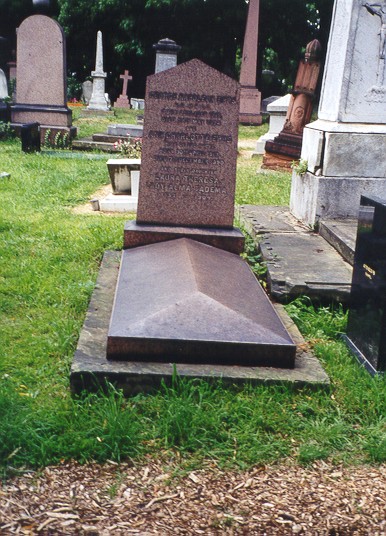 George Napoleon Epps
1815-1874 (photo curtesy of Dr Gary Bovine, Canada), RCGP 1845, brother
of John Epps, half brother of James Epps, and father of Washington Epps,
Hahneman Epps, Laura Theresa, Lady
Alma
Tadema,
and Ellen Nellie Epps
Gosse.
George Napoleon Epps
1815-1874 (photo curtesy of Dr Gary Bovine, Canada), RCGP 1845, brother
of John Epps, half brother of James Epps, and father of Washington Epps,
Hahneman Epps, Laura Theresa, Lady
Alma
Tadema,
and Ellen Nellie Epps
Gosse.
George Napoleon Epps homeopathic practitioner, Surgeon to the Homeopathic Hospital at 17 Hanover Square, London, 1845, where he specialised in spinal curvature and spinal deformities. He was also interested in the diseases of infants, children and women. George had a large practice to which he was ’… much devoted, never sleeping away from his house for twenty years…’ His practice was located at 30 Upper King Street, Bloomsbury in 1840, later moving to 112 Great Russell Street, Bloomsbury in 1842. In 1847, he was practicing at South Audley Street, and in 1849, he was living at 10 Grafton Road, and possibly practicing at 272 Marylebone Road. (D Betty Griffin, Biggin Wood Norbury, (Local History Publications, Streatham 2005) Chapter 5).
George Napoleon Epps is buried at the Kensal Green Cemetery.
** 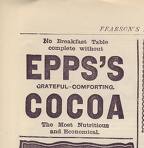 James Epps** (1821-1907) a homeopathic
chemist in the Euston
Road,
at 112 Great Russell Street, 82 Old Bond
Street
and in
Piccadilly,
was the founder of the
James Epps** (1821-1907) a homeopathic
chemist in the Euston
Road,
at 112 Great Russell Street, 82 Old Bond
Street
and in
Piccadilly,
was the founder of the 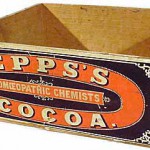 great cocoa
business associated with his
name.
great cocoa
business associated with his
name.
From D Betty Griffin, Biggin Wood Norbury, (Local History Publications, Streatham 2005) Chapter 5. James was born in Middlesex (?London). He married Sarah (born 1818 in Wateringbury, Kent-died Biggin Wood House 11.6.1899) and their children, all born in Middlesex (though the family were probably living in London as in those days all the City of London was included in the Middlesex census), were Anna (DOB 30.8.1852), Willie James (DOB 23.6.1856-DOD in Jamaica on 20.2.1905), Sara (born 1860). D Betty Griffin notes that in James’s Will (valued at £735,387 10s 0d - equivalent to £42,174,473.13 in todays money), these children were recorded as the ‘reputed’ children of James, so it is possible that they were not his children, but that they ‘passed as such’. The Epps Coca Works was supposed to have been founded in 1839, and in 1860, the factory is listed as located at 398 Euston Road. In 1872, the factory had extended to 6-8 Diana Place NW, and 15a High Street Vaden Town, with their shipping agent as Clark and Cresswell at 2 Gresham Buildings, EC. James also owned a cocoa plantation in Jamaica and he may even have owned a boat to ship the cargo. Note that in James Epps’ time, all the plantation workers will have been freed slaves. In 1879, the new factory was founded in Holland Street, Bankside (operating alongside the Euston Road branch), and described as ’… a large 3 storied building occupying about 2 acres with a basement. Above the entrance porch was a clock surmounted by a dome, the height of which was 110 feet from the ground. There was to be a covered carriage way by which vans would reach a large area at the south east side of the building. Externally, the building was to be faced with red Suffolk brick with Bat stone dressings and a rusticated front on ground floor level. The construction of the walls are supported by cast iron columns, the roofs are of slate… the total cost of the building will possibly exceed £60,000 (£2,898,600.00 in today’s money)…’ Epps Homeopathic Cocoa was ’… sold from Victorian times until 1930, and each packet was labelled as ‘James Epps, Homeopathic Chemist, London’…’ James practiced as a homeopathic chemist at 43 Threadeedle Street, EC1, 170 Piccadilly, W1, and also at 112 Great Russell Street and 82 Old Broad Street. James Epps brought 8 acres of land stretching between Norbury Hill, Beulah Hill and Biggin Hill, and the Norfolk House (?built 1890s) is still standing today (and run a the Norfolk Court Hotel). In 1879, James Epps brought Biggin Wood House and estate, and he lived there with Sarah for over 30 years, and after his death, his son Willie lived there, the estate then passed to James’ nephew Washington Epps, and then to Hahnemann Epps, and in 1908, the house was brought by Annie, and she lived there until 1924 (she died in 1925). In her will (valued at £43,447 (£1,302,106.59 in today’s money) Annie left Biggin Wood House to her nephew James Epps, who was living at Norfolk House Her late brother’s house) at this time, and the house was administered by Sarah Linton (did 1931) and her two children Francis (died 1935) and Sylvia (living abroad = never lived in the house and she died in 1964 in Hindhead Surry). Annie left many bequests, including £1000 (£29,970.00 in today’s money) to the London Homeopathic Hospital. The Holland House Cocoa factory shut down in 1930 and Biggin Wood House was unoccupied (?fron 1935). There are many Epps graves in the Wes Norwood Cemetery.
James Epps provided foodstuffs for the Athenaeum Club, who did not distinguish themselves when they prevented homeopath Frederick Hervey Foster Quin from becoming a member, but were quite happy to munch on ‘homeopathic confectionaries’!
James Epps manufactured homeopathic remedy kits and explanatory
booklets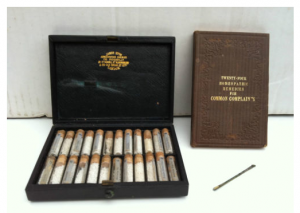
James Epps homeopathic pharmacy supplied remedies to Samuel Brooking for his trip to India:
Surgeon Samuel Brooking, a retired Medical Officer had the courage and conviction to establish a Homeopathic Hospital at Tanjore, in South India, in 1847…
James Epps also provided homeopathic remedies for James Manby Gully.
James Epps is buried in West Norwood cemetery See the Friends of West Norwood Cemetery web site http://www.fownc.org/ with special thanks to Colin Fenn, the vice chairman of the Friends of West Norwood cemetery email 28.3.12 ‘… you might also like to know that we have James Epps buried here too. __James was trained as a homeopathic chemist but became very wealthy as a cocoa manufacturer, which he promoted as a health-giving drink. He included homeopathic quantities of minerals etc. in his concoction. A brother was George Napoleon Epps (1815–1874), a British homeopathic practitioner. The physician, phrenologist and homeopath John Epps (1805–1869) was his half-brother. These two were buried at Kensal Green, but James ended his days in Norwood. Both are described in the Dictionary of National Biography, though James, as a successful businessman, isn’t!...’
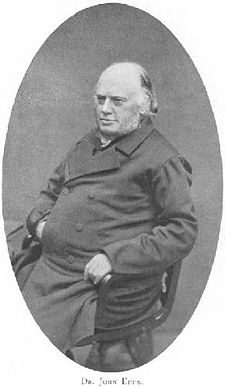 John
Epps 1805-1869 (photo used
courtesy of Homéopathe
International) was an orthodox
physician who converted to homeopathy in
1838 (Christopher
Hoolihan, An Annotated Catalogue of the Edward C. Atwater Collection
of American Popular Medicine and Health
Reform.
(University Rochester Press, 2001). Page 294), and is best known as a
homeopathic physician, although his influence was wider reaching being
involved, as he was, in ‘the advancement of commercial, political or
religious freedom’.
John
Epps 1805-1869 (photo used
courtesy of Homéopathe
International) was an orthodox
physician who converted to homeopathy in
1838 (Christopher
Hoolihan, An Annotated Catalogue of the Edward C. Atwater Collection
of American Popular Medicine and Health
Reform.
(University Rochester Press, 2001). Page 294), and is best known as a
homeopathic physician, although his influence was wider reaching being
involved, as he was, in ‘the advancement of commercial, political or
religious freedom’.
John Epps was a graduate of the University of Edinburgh, lecturer on Materia Medica and Chemistry, Director of the Royal Jennerian and London Vaccine Institutions and a member of the Committee of the Westminster Medical Society.
Bovine G, Silver JR, Weiner MF, * The role of Edward Harrison’s (1766-1838) disciples, Thomas Engall, John and George Epps, Charles Hoyland, John Evans Riadore, John Robinson and John Baptiste de Serney in the treatment of spinal deformity in the Victorian medical world*. J Med Biogr. 2012 Feb;20(1):18-24.
From D Betty Griffin, Biggin Wood Norbury, (Local History Publications, Streatham 2005) Chapter 5. John Epps practiced as an orthodox physician at 10 Castle Street, Oxford Market (In Kent?) in 1834, and later as a homeopath at 89 Great Russell Street, Bloomsbury, London WC1. He is described as short of stature, sturdy of frame, with a beaming self confidence.
John Epps was the homeopathic practitioner of Charlotte Bronte and Emily Bronte (who unfortunately refused all medicines before she died), the sister of Peter Stuart (L Finigan, The Life of Peter Stuart, the “Ditton Doctor”. [With Plates, Including Portraits and Facsimiles], (for family circulation 2nd edition, published by Books Limited, 187 Fleet Street London EC4 (Clifford’s Inn Passage), 1920, and by Liverpool and Prescot 1921). Page 80), and George Wilson, the teacher of James Chalmers,
John Epps was a friend of John Bright, Francis Burdett, Lady Byron, John Chapman, Richard Cobden, George Combe and Andrew Combe, Paul Francois Curie, Charles Dickens, Felice Orsini, Thomas Slingsby Duncombe, Harris F Dunsford, W J Fox, Giuseppe Garibaldi, Richard Walter Heurtley, Joseph Hume, Lajos Kossuth, Giuseppe Mazzini, Robert Owen, Francis Place, Frederick Hervey Foster Quin, Marmaduke Blake Sampson, Samuel Smiles, James Stansfeld, Thomas Wakley, James John Garth Wilkinson, George Wilson,
From _[Some Abiding Themes Hewn from British Homeopathic History](http://www.homeoint.org/morrell/articles/abiding.htm)_ by Peter Morrell. '... In contrast to devotees of high potency, for doctors like ‘… [John James ](/archives/2008/07/29/the-drysdale-family-and-homeopathy/)_[Drysdale](/archives/2008/07/29/the-drysdale-family-and-homeopathy/)… low dilutions did best and he found no advantage above the 3rd decimal…’ _(Frank Bodman, _Richard Hughes Memorial Lecture_, _British Homeopathic Journal 59,_ (1970). Page184). [Thus the 3x became the officially approved and standard tool of UK homeopathic practice from 1830 to 1900](http://www.homeoint.org/morrell/articles/abiding.htm). The early UK homeopaths therefore comprised ‘… _a remarkably able cohort of 3x men – [Stephen Yeldham](/archives/2008/10/01/stephen-yeldham-1810-1896/), [John Galley Blackley](/archives/2008/11/21/the-blackley-surname-and-homeopathy/), [John Moorhead Byres Moir](/archives/2008/12/06/john-moorhead-byres-moir-1853-1928/), Washington Epps, [C T Knox Shaw](/archives/2009/03/27/c-t-knox-shaw-1865-1923/), etc…’ _to which we can also add the names of ‘… John Epps_, [Paul Francois Curie](/archives/2008/07/26/paul-francois-curie-and-homeopathy/), [David Wilson](../archives/2008/10/04/david-wilson-1811-1889/) as well as [Alfred Crosby Pope](/archives/2009/03/29/alfred-crosby-pope-1830-1908/), [Richard Hughes](/archives/2008/07/04/richard-hughes-and-homeopathy/), [David Dyce Brown](/archives/2008/12/14/david-dyce-brown-1840-1910/),… [William Bayes](/archives/2008/08/05/william-bayes-and-homeopathy/), [Thomas Robinson Leadam](/archives/2008/10/04/thomas-robinson-leadam-1809-1881/) and [Robert Ellis Dudgeon](/archives/2009/05/18/archives/2009/08/29/robert-ellis-dudgeon-1820-1904/)_…’' (A Taylor Smith, _letter re Dr Borland’s Obituary_, _British Homeopathic Journal 50.2_, (July 1961). Page 119 and page 123).
As an allopath, John Epps had been a frequent contributor to The Lancet . In 1843 his homeopathically treated case of haematemesis was published in The Lancet provoking ”an avalanche of letters” which led to the rejection of further homeopathic cases. This despite the fact that John Epps had been contributing papers, letters and homeopathic cases to The Lancet since 1841, which had provoked a similar stream of comments and letters ( Thomas Wakley (Ed.), The lancet, Volume 2, (J. Onwhyn, 1841). Pages 362-365 A Case of Arnica, and pages 440-1 and pages 547).
By the 1850s, John Epps was the leading practitioner of homeopathy in London. He practiced at 89 Great Russell Street and a frequent contributor to the British Journal of Homeopathy, and he contributed cases to The Journal of Health and Disease.
The Times designated John Epps as the Physician in General to the British Constitution.
John Epps was on the Management Committee of the English Homeopathic Association alongside William Henry Ashurst, John Burnett, Edward Cronin, Paul Francois Curie, A O Deacon, Robert S Dick, George Napoleon Epps, Robert Frith, Joseph Glover, Robert Grosvenor, George Hayes, Thomas H Johnstone, Henry Kelsall, John Miller, William MacOubrey, Henry P Osman, Charles Thomas Pearce, William Perkins, George K Prince, James Stansfeld, Peter Stuart, Allan Templeton, James Thomson, William Warne, James Wilson,
The English Homeopathic Association petitioned Parliament in defense of Charles Thomas Pearce, about the outrage of such false accusations, especially as there was no redress in law for the damage done to the defendant. The petition was seconded by John Epps, in the company of William Henry Ashurst, John Burnett, Edward Cronin, Paul Francois Curie, A O Deacon, Robert S Dick, George Napoleon Epps, Robert Frith, Joseph Glover, Robert Grosvenor, George Hayes, Thomas H Johnstone, Henry Kelsall, John Miller, Henry P Osman,, William MacOubrey, Charles Thomas Pearce, William Perkins, George K Prince, James Stansfeld, Peter Stuart, Allan Templeton, James Thomson, William Warne, and James Wilson.
Tait’s Edinburgh magazine, on reviewing his book Constipation, its cause and cure, commented that ’there are some books not even critics criticise; this book is one of them…’ _Tait’s Edinburgh magazine_ _was equally full of praise for John Epps’s book _Homeopathy and its Principles Explained_… _
John Epps successfully treated spinal deformity and worked in Edward Harrison’s Spinal Unit:
All of Epps and Harrison’s descriptions refer to patients treated at home, and there is no record of their work at the institute.
John Epps formed the British Homeopathic Association, based upon his democratic values and encouraging lay and domestic healing, particularly attracting middle-class mothers.
John Epps was a Swedenborgian (based on the works of Emanuel Swedenborg), and he was active in the Anti Corn Law League, his convictions honed by a ’lifetime’s pilgrimage’ through several sects (active at this time)… and he was a friend of John Bright, Richard Cobden, and George Wilson, who was his patient…
John Epps was a radical dissenter. One of the very few nineteenth century homeopaths who really saw medicine as a tool of liberation for the poor and lower classes, and who was a compassionate religious non-conformist…
Charles Darwin… was not alone in extending the ethical net from oppressed men to the forlorn brutes. The Quaker doctor John Epps, London phrenologist, homeopath and disestablishment campaigner, had ‘come to consider all creatures as being equally important in the scale of creation as myself; to regard the poor Indian slave as my brother.’
… ‘the whole creation travaileth and groaneth’. This was John Epps’s reading of St Paul. He was adamant that ‘animals enjoy mind, and with it personality, desires and pain’
… John Epps ‘was of short stature and sturdy frame, and had a beaming, self confident expression. He was regarded by many of the working classes as a prophet in medicine…
he impressed many people with… his great earnestness… and his evident desire to benefit his fellow creatures. He had a great command of words, a fine sonorous voice, and an animated manner. His philanthropic efforts and personal acts of kindness were numberless.’
He was also ‘an ardent champion of liberal causes at home and of oppressed nationalities abroad.’ Which is I suppose a very polite way of saying he was also well connected with many other rebels of the day.
These include Giuseppe Garibaldi the Italian patriot; Lajos Kossuth the Hungarian revolutionary who stayed in London for a time in the 1850s where he ‘was received with respect and sympathy’; and Giuseppe Mazzini, another important Italian patriot who ‘found refuge in London in 1837’. No doubt at Dr Epps’s house. (NB: Lajos Kossuth’s envoy Mathias Roth was a collegue of John Epps (**Mathias Roth**** ****(****1818-1891)** MD Pavia 1839 was a Hungarian refugee who converted to homeopathy in Hungary. He was an Orthopaedic Surgeon and a Physician at the Hahnemann Hospital at 39 Bloomsbury Square, and a member of the Hahnemann Medical Society. Lajos Kossuth asked Mathias Roth to be his envoy to Britain, and while he was traveling, the war in Hungary was lost. Roth stayed in Britain for the rest of his life).
Giuseppe Mazzini also stayed with John Chapman at 142 Strand.
John Epps trained James Chalmers in medicine:
After spending eight months working with people in the worst slums of Glasgow, James Chalmers studied for two years in Cheshunt College, then stayed one year at Highgate where he took special studies, including elementary medicine in Dr. Epps’ Homeopathic Hospital.
John Epps founded the Westminster Homeopathic Dispensary in 1835.
In 1845, the British Homeopathic Association was formed with Marmaduke Blake Sampson, Richard Walter Heurtley and John Epps.
John Epps London, MD Edinburgh 1827, born 15-2-1805 Ashford, Kent, died 12-2-1869 London [from Diary of the Late John Epps]; formerly a Lecturer in Materia Medica and Botany at the Hunterian School of Medicine, London, John Epps was a political, religious and medical radical, who was loosely associated with Frederick Hervey Foster Quin, and more closely with Paul Francois Curie, Harris F Dunsford, the co-founders of the radical and breakaway British Homeopathic Association, in direct opposition to the British Homeopathic Society.
Charlotte Bronte’s publisher Smith, Elder and Co in Cornhill sent her a book on homeopathy, and William Smith Williams of Smith, Elder and Co also sent her a book on homeopathy and advised her to call a homeopath for Ellis Bell (Emily Bronte’s pseudonym).
(photo by curtesy of Dr. Gary Bovine) Laurence Alma Tadema married the sister of William Smith Williams’ daughter in law in 1871. She was Laura Epps the daughter of George Napoleon Epps the half brother of homeopath John Epps whom Charlotte Bronte consulted about homeopathic help for Emily Bronte. Charlotte was an advocate of homeopathy and she tried to persuade Emily to try it. In desperation, Charlotte Bronte wrote to John Epps, a homeopathic physician for advice about Emily, who tragically refused all medications at her end.
John Epps was a witness at the Old Bailey on 3.1.1833 for the whole proceedings on the King’s Commission of the Peace, Oyer and terminer and gaol delivery for the City of London, and gaol delivery for the County of Middlesex.
John Epps the eldest son of John Epps (see Epps family), was born into a Calvinist family in Sevenoaks, Kent in 1805.
He became disillusioned with the religious atmosphere he found himself in and, after being educated at the Protestant Dissenters’ Grammar School, Mill Hill (near Hendon), and, at 15, serving an apprenticeship to a apothecary of the name of Dury, he relocating in 1824, at the age of 18, to Edinburgh to study medicine.
While in Edinburgh he embraced the views on phrenology of Franz Joseph Gall and Johann Spurzheim and became friends with Scot phrenologists George Combe and Andrew Combe. In 1827 Epps graduated with his degree at the age of 21.
He saw medicine as ‘a tool of liberation for the poor and lower classes’.
Epps authored a number of books during his life, starting before he attended university with, among other things, a work titled A New Way of Teaching English Grammar.
Immediately after graduating he moved back to London (eventually settling in Great Russell Street) where he began to practice (it is recorded that he was ‘much liked by, and inspired great confidence in his patients’) and also to lecture (initially at Aldersgate School of Medicine, and afterward at Westminster) on ‘chemistry, botany, and materia medica’ at the Hunterian School of Medicine.
Here he published An Introduction to Botany, which was intended as a textbook for his students, and two books on phrenology called Evidences of Christianity Deduced from Phrenology and _Horae Phrenologicae Being Three Phrenological Essays_.
Throughout his adult life he lectured publically and extensively, particularly on phrenology and homoeopathy, both in London and in other large towns; when his health failed he continued to lecture in his own home.
Epps was drawn to homeopathy in about 1837 after reading the works of Paul Francis Curie (his greatest influence in homeopathy, apart from Paul Francis Curie, was Samuel Hahnemann and his work The Organon of the Healing Art), and his first essay on homeopathy appeared the following year.
In line with his political views (see Political involvement below), John Epps had a ‘very large homeopathic practice, especially among the lower middle and lower classes of society ’, although he also had medical involvement with more well known people, such as Charlotte Bronte and Emily Bronte.
In 1831 he married and became Medical Director of the Royal Jennerian and London Vaccine Institution, an institution which up to his death he supported.
John Epps was a frequent contributor to The Lancet until he adopted homeopathy. In 1843 The Lancet refused to publish reports of homeopathic treatment; John Epps took these rejected articles and published them in a pamphlet entitled Rejected Cases, which also contained a vigorous letter to the editor of The Lancet (his friend, Thomas Wakley).
Epps was also involved in a number of other journals: He was for some time co-editor of the London Medical and Surgical Journal, and for a long period conducted the Christian Physician and Anthropological Magazine (1836-9), and The Journal of Health and Disease. He established a journal, Notes of a New Truth, for the propagation to nonprofessionals of the “new school” of homeopathy, to which he contributed up to the time of his decease.
As with Notes of a New Truth, the majority of Epps’ lectures were directed at nonprofessionals. However, he also lectured to medical professionals and was lecturer on materia medica at the Homeopathic Hospital, Hanover Square (c. 1861).
On the 31st of January 1869 Epps was ‘attacked with paralysis’ and, after a further ‘attack of paralysis, aggravated by acute asthma, from cold’ he died, at the age of 64, on February 12th. He was interred at Kensal Green Cemetery, February 10th, 1869, in the presence of a large number of political, medical and personal friends.
John Epps … was involved in procuring the repeal of the Test Acts (1829) and, along with Francis Place, W. J. Fox, Francis Burdett and others, with the passing the Reform Bill of 1832.
His campaigning for social justice also lead him to become a Chartist (in 1847 he stood for parliament with Chartist backing), and he was an active member of the Anti Corn Law League and joined organizations in favor of the Polish, Italian, Hungarian, and American nationalities.
It is evident from his extensive lecturing on phrenology and homeopathy that Epps enjoyed giving public addresses, and the British Journal of Homeopathy remarks that he was ‘as keenly fond of making a speech denouncing tyrants anywhere in the world as of giving a lecture on phrenology or Homeopathy’.
These frequent public appearances, and the active part Dr. Epps took against ‘Church Rates [tax], war, despots, corn laws, and other old institutions’, brought him into contact with many noted individuals, such as Joseph Hume, Lady Byron, George Wilson, (president of the Anti Corn Law League), Giuseppe Mazzini, Thomas Slingsby Duncombe, James Stansfeld, Lajos Kossuth, and Robert Owen.
From an early age he declared himself an enemy to church establishments and a paid ministry, which can be seen in some of the parlimentary reforms he pushed for. Epps strongly opposed church rates. He denounced the larger Protestant churches as being the “harlot daughters of Rome [i.e. the Roman Catholic Church]“.
While in Edinburgh he joined the Nonconformist Scotch Baptists who had no fixed minister, but those who were moved spoke. In this environment, at the age of 19, Epps became a preacher. However, when he returned to London he left the Scotch Baptists because there the sect was run more like the church systems he rejected. After this, regularly and for many years, he began preaching to mechanics at Dock Head Church.
Not only did Epps reject the orthodox church establisments, but he also rejected a number of the mainstream Christian doctrines. He rejected the doctrine of the immortal soul, emphasising instead resurrection as the escape from death. In this vain, the second coming of Christ is also emphasised.
Hell is the grave, he taught, not the place of torment of mainstream Christianity. He also rejected the Trinity, stating that Jesus is the Son of God, a human by nature. He also spoke out against the glorification of war-heroes: “the honour of the British flag is a specious phrase which blinds men’s eyes to right and wrong”, he said.
The most infamous of Epps’ unorthodox views regards the devil. According to Epps, references in the Bible to the devil and satan are, in the main, to be understood as personifications of the lustful principle in man.
In 1842 he anonymously published a work on this subject entitled The Devil: a Biblical exposition of the truth concerning that old serpent, the devil and Satan and a refutation of the beliefs obtaining in the world regarding sin and its source. The publication brought considerable opposition and, according to historian Alan Eyre, ‘a lecture given shortly afterward to the Tooting Institution at the Mitre Inn in … London … caused serious offense and led to widespread ostracism and hostility’.
Similarity, a few years prior to this he delivered a series of lectures at the Dock Head Church to demonstrate that the devil is not a personal being and ‘this bold assertion drew upon him a world of abuse, and some patients declined to be treated by one holding such heterodox views’.
John Epps’ faith stayed with him throughout his life; it is recorded that ‘with his last breath he expressed his humble, yet confident faith in the power, wisdom, and goodness of the Great Father of all spirits’.
John Epps and his wife Ellie are
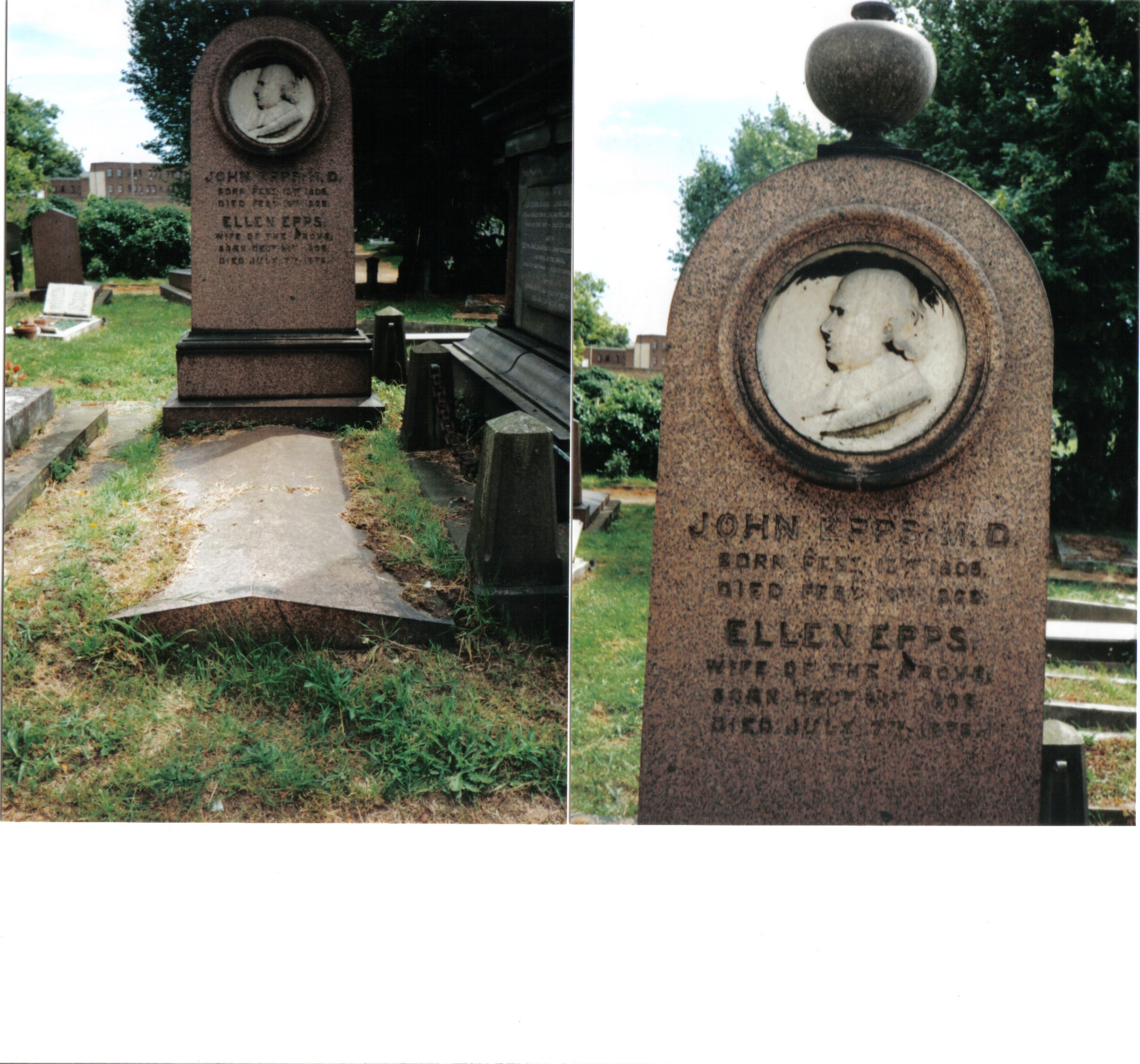 buried in the Kensal
Green Cemetery in the ‘Dissenters’
Section
(photo courtesy of Phil Nicholls Emeritus Professor of Sociology,
Staffordshire University).
buried in the Kensal
Green Cemetery in the ‘Dissenters’
Section
(photo courtesy of Phil Nicholls Emeritus Professor of Sociology,
Staffordshire University).
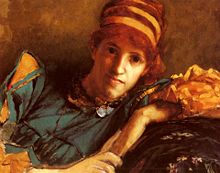 Laura Therese
Epps 1852 –
1909 was from 1871 the second wife of the painter Lawrence Alma
Tadema and a painter
in her own right.
Laura Therese
Epps 1852 –
1909 was from 1871 the second wife of the painter Lawrence Alma
Tadema and a painter
in her own right.
Laura Epps the daughter of George Napoleon Epps the brother of John Epps.
Laura and Lawrence were friends of Coutts Lindsay 2nd Baronet Trotter of Westville,
Laura Epps’ two sisters were also painters (Emily Epps studied under John Brett, a Pre-Raphaelite, and Ellen Nellie Epps under Ford Madox Brown), whilst Edmund William Gosse and *Rowland Hill were her brothers in law.
http://en.wikipedia.org/wiki/Laura_Theresa_Alma-Tadema It was at Ford Madox Brown’s home that Lawrence Alma Tadema first met her in December 1869, when she was aged 17 and he 33. (His first wife had died in May that year.) He fell in love at first sight, and so it was partly her presence in London (and partly the fact that only in England had his work consistently sold) that influenced him into relocating in England rather than elsewhere when forced to leave the continent by the outbreak of the Franco Prussian War in July 1870.
Arriving in London at the beginning of September 1870 with his small daughters and sister Artje, Lawrence Alma-Tadema wasted no time in contacting Laura, and it was arranged that he would give her painting lessons. During one of these, he proposed marriage. As he was then thirty-four and Laura was now only eighteen, her father was initially opposed to the idea. John Epps finally agreed on the condition that they should wait until they knew each other better.
They married in July 1871 and, though this second marriage proved childless, it also proved enduring and happy, with Laura acting as stepmother to her husband’s children by his first marriage.
The Paris Salon in 1873 gave Laura her first success in painting, and five years later, at the Paris International Exhibition, she was one of only two English women artists exhibited. Her other venues included the Royal Academy (from 1873), the Grosvenor Gallery and others in London.
She also had occasional work as an illustrator, particularly for the English Illustrated Magazine, and was well known as a hostess in their London residences at Regents Park and Grove-end Road. A memorial exhibition of her work was held at the Fine Art Society in 1910.
As well as frequently being painted by her husband after their marriage (The Women of Amphissa of 1887 being a notable example), she is also shown in a seated statuette by Amendola in 1879, a bust by Delou in 1876, and a portrait by Jules Bastien-Lepage.
She specialised in highly sentimental domestic and genre scenes of women and children, often in Dutch seventeenth-century settings and style, like Love’s Beginning, Hush-a-bye, The Carol, At the Doorway (c.1898, shown right) and Sunshine. She did paint some classical subjects and landscapes akin to those of her husband, but in general her main influence was 17th century Dutch art, which was a far less restrained influence in her work than his.
Ernest Gambart, the picture dealer, wrote to the artist William Holman Hunt, ‘Tadema went last Boxing Day [26 December 1869] to a dance at Ford Madox Brown’s, fell in love at first sight with Miss Epps, the surgeon’s daughter, and is going to marry her as soon as she names the day - it plays havoc with his painting; he cannot turn to work since.’
Laura Epps and Alma Tadema married in 1871. Within the screen image from the left is Laura’s father, Dr George Napoleon Epps, surgeon and homeopathic physician, who sits at the head of the table with his wife, Anne Charlotte Bacon.
Next are Mary Ann Camille Epps, with her husband, Laura’s uncle Dr Hahnemann Epps (who was always known as Tim Epps), who was both a homeopathic practitioner and a cocoa manufacturer, and their two small children George and Edith.
Ellen Epps (who later married Alma Tadema’s biographer Edmund William Gosse) is partly obscured by Emily, resplendent in a white gown. Both girls, like their sister Laura, were artists.
Emily faces her brother in law Charles Pratt, a wine merchant, and his wife, Amy Epps.
*Rowland Hill appears twice, peering round the screen and also standing ghost like beside his wife, Louisa Epps 1846 - 1909, who holds their baby Charlotte. (The full length figure of *Rowland Hill was painted out - probably because of a financial scandal that caused him and his wife to flee to Argentina in 1871 - but over a time the paint layers have become transparent.)
Next are Frances Epps, her husband, Dr Washington Epps, also a homeopathic practitioner, and his sister Laura, wearing green. Through the door there is a self-portrait of Alma Tadema. Next to him is Laura’s uncle Elizabeth, who married that year and later emigrated to Omaha, Nebraska, USA.
The inscription that runs across the top of the screen is from Aesop’s fables. It extols the strength to be found in a united family. This is somewhat ironic in view of *Rowland Hill’s subsequent disgrace and estrangement from the Epps clan.
 Richard Epps
practiced at 22 Charlotte Street, Bedford
Square.
Richard Epps
practiced at 22 Charlotte Street, Bedford
Square.
The London Homeopathic Hospital was founded on 10.8.1850 by Frederick Hervey Foster Quin for the free treatment of the capital’s sick poor. It opened its doors to patients on Hahnemann’s birthday 10 April 1850.
The London Homeopathic Hospital has been rebuilt and extended several times from the original building. This book contains a lot of information about the London Homeopathic Hospital up to the year 1914. It was compiled by Dr. Richard Epps, a member of that great ‘homeopathic family’ of Epps’s, based in the London area with their homeopathic pharmacies in Threadneedle Street, in the City and at 60 Jermyn Street, St. James’s, London, SW1.
‘Epps Thatcher’ pharmacies were first established in 1839, but had all gone by 1962
Washington Epps 1848-1912 (photo curtesy
of 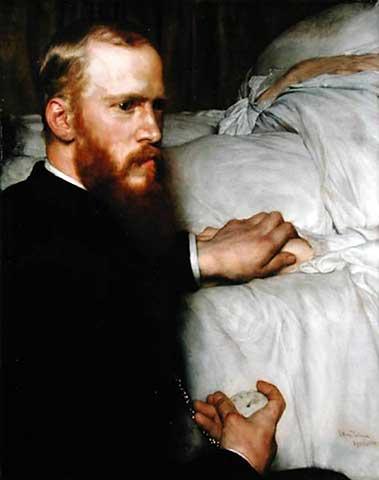 Dr Gary Bovine, Canada) LRCP Senior
Assistant
Physician,
London Homeopathic
Hospital
also practiced at 80 Great Russell
Street
Dr Gary Bovine, Canada) LRCP Senior
Assistant
Physician,
London Homeopathic
Hospital
also practiced at 80 Great Russell
Street
Washington Epps MBHS, MRCS England 1871, LRCP Edinburgh, LM Edin. 1871. Assistant Physician at the London Homeopathic Hospital in 1889 (Anon, London Homoeopathic Hospital Reports, Volumes 3-4, (London Homoeopathic Hospital, 1893). Page x).
From Some Abiding Themes Hewn from British Homeopathic History by Peter Morrell. ‘… In contrast to devotees of high potency, for doctors like ‘… John James Drysdale… low dilutions did best and he found no advantage above the 3rd decimal…’ *(Frank Bodman, *Richard Hughes Memorial Lecture, British Homeopathic Journal 59, (1970). Page184). Thus the 3x became the officially approved and standard tool of UK homeopathic practice from 1830 to 1900. The early UK homeopaths therefore comprised ‘… a remarkably able cohort of 3x men – Stephen Yeldham, John Galley Blackley, John Moorhead Byres Moir, Washington Epps, C T Knox Shaw, etc…’ _to which we can also add the names of ‘… John Epps, Paul Francois Curie, David Wilson as well as Alfred Crosby Pope, Richard Hughes, David Dyce Brown,… William Bayes, Thomas Robinson Leadam and Robert Ellis Dudgeon…’’ (A Taylor Smith, _letter re Dr Borland’s Obituary, British Homeopathic Journal 50.2, (July 1961). Page 119 and page 123).
Washington Epps died at his residence in Wellgarth Road, Hampstead, there passed away as gently as he had lived, Washington Epps, the last medical representative of a family intimately associated with the rise and progress of homeopathy in the UK.
He was the youngest son of George Napoleon Epps, and nephew of John Epps, of Richard Epps, and of James Epps, the homeopathic chemist, all of whom were intimately concerned, in the early days of homeopathy, in its being brought, by means of lectures and pamphlets, within the purview of the intelligent laity all over the kingdom.’
Washington Epps was at the London Homeopathic Hospital in the early days and during its rebuilding and extension. In a very busy life, numerous items also flowed from his pen, including 14 articles in the journals and a sound homeopathic text on skin conditions -Skin Diseases Treated Homeopathically and ‘now in its fourth edition’.
Charles Edwin Wheeler says he was ‘of strikingly handsome personal appearance…and very much beloved by all his patients.’ Upon his cremation on Thursday 17 October 1912, at Golders Green, nearly all the medical and surgical staff of the London Homeopathic Hospital were present.
Washington Epps attended (Anon, The Homeopathic World, Volume 43, (1908). Page 236) the 2nd International Homeopathic Congress held in London (Anon, The Medical Counselor, Volume 7, (The Michigan State Homeopathic Society, 1883). Page 347) in on 11th-18th July 1881 (Anon, The Homeopathic World, (August 1,1881)) at Aberdeen House, Argyll Street, Regent Street.
Washington Epps gave lectures and was a contributor to the Journal of the British Homeopathic Society.
The Epps family were also publishers. James Epps & Co published James Compton Burnett’s _Diseases of the Spleen. _The Epps books were published in America by Otis Clapp.
Ellen Elliott Epps wrote The living among the dead, Blenham; or, What came of troubling the waters, Practical observations on health and long life,
Ellen (Nellie) Epps wrote children’s stories, contributed to various journals.
George Napoleon Epps wrote On Deformities of the Spine and on Club Foot,
James Epps wrote Dog Diseases treated by Homeopathy
John Epps wrote The life of John Walker, Homeopathy and Its Principles Explained, Horae Phrenologicae Being Three Phrenological Essays, Evidences of Christianity Deduced from Phrenology, Lectures on Physiology in relation to the influence of parents on the offspring, Constipation, its cause and cure, Consumption and its treatment, Spinal Curvature, its theory and cure, The Homeopathic Family Instructor, The Homeopathic Domestic Physician with Joseph Hyppolyte Pulte, Diseases of Women, Diseases of Children, Ovarian and Womb Diseases: Their Causes, Diagnosis, and Cure, The Rejected Cases: With a Letter to Thomas Wakley, Diary of the Late John Epps, M.D. Edin: Embracing Autobiographical Records with Ellen Gosse and Ellen Elliott Epps, On the Virtues of Arnica, Affections of Women, Affections of the Head and Nervous Systems, Epilepsy and some nervous affections, On Arnica Montana, and he edited Notes of a New Truth and was co-editor of the London Medical and Surgical Journal, and for a long period conducted the Christian Physician and Anthropological Magazine and The Journal of Health and Disease. Joh Epps also wrote The Devil: a Biblical exposition of the truth concerning that old serpent, the devil and Satan and a refutation of the beliefs obtaining in the world regarding sin and its source.
Washington Epps wrote many journal articles.
Of interest:
*Rowland Hill (1843-1879) (also spelt Roland Hill)** -** not to be confused with Rowland Hill (1795 - 1879).
From Rootsweb 1.6.1998: LAURA ALMA-TADEMA had a sister LOUISA EPPS (1846-1909), who married RO(W)LAND HILL, born St Pancras, Middlesex, London, 6 July 1843. ROWLAND HILL was a London stockbroker. According to art historical sources he was involved in a stock market scandal and was obliged to flee to Argentina with his family. This must have been in circa 1872. ROWLAND and LAURA had three children: a. CHARLOTTE ANN HILL, born St Pancras, Middlesex, London, 5 April 1870,died in England; b. CIRILA CATHERINE HILL, born in Argentina 1873/74, died in England; and c. JOHN CRASSWELLER HILL, born in Argentina 1875/76/77, died in England. ROWLAND HILL himself died in Argentina in circa 1879 (before 1881). Unfortunately it is not yet known where in Argentina this family settled. The widow and the three children came back to England in circa 1881. Who could advice me on how to find the precise birth data of the two children born in Argentina and the precise death data of ROWLAND HILL ?
[From Rootsweb 2.9.1998: Roland HILL, son of John HILL and Ann CRASWELLER, was born at 3 Regent Place, St Pancras, London, on 16 June
- He was a stock broker, got involved in a scandal and fled with his family to Argentina](http://archiver.rootsweb.ancestry.com/th/read/SOUTH-AM-EMI/1998-09/0904737976), probably first to Rosario where a daughter was born (and died) in
- According to the Calendar of Wills for 1879 and 1880 he died 18 June 1879. At the probation of his will he is described as formerly of Hungerford Road, Camden Road,Middlesex and of the Stock Exchange London, but late of “Villa Maria, Santa Fe, Argentina”. Unfortunately no town of that name exists in the province of Santa Fe. There is a Villa Maria in the province of Cordoba, but I do not know whether that town is ment. Can one of the readers give some information on this question or perhaps verify in Villa Maria, Cordoba, whether Roland HILL died there?? Roland and his wife Louisa HILL (nee EPPS) had the daughter mentioned above baptized in the St Bartholomew Anglican Church in Rosario, Santa Fe, but it is not sure whether they lived there. They may have come to that church just for church affairs only.
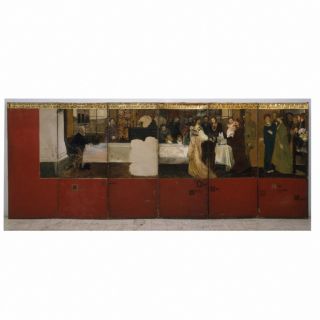 screen is the
result of Laura Epps’ painting lessons with the artist Sir Lawrence
Alma Tadema (1836-1912). He painted portraits of all the Epps family
on six large canvases, with Laura adding touches
afterwards
screen is the
result of Laura Epps’ painting lessons with the artist Sir Lawrence
Alma Tadema (1836-1912). He painted portraits of all the Epps family
on six large canvases, with Laura adding touches
afterwards